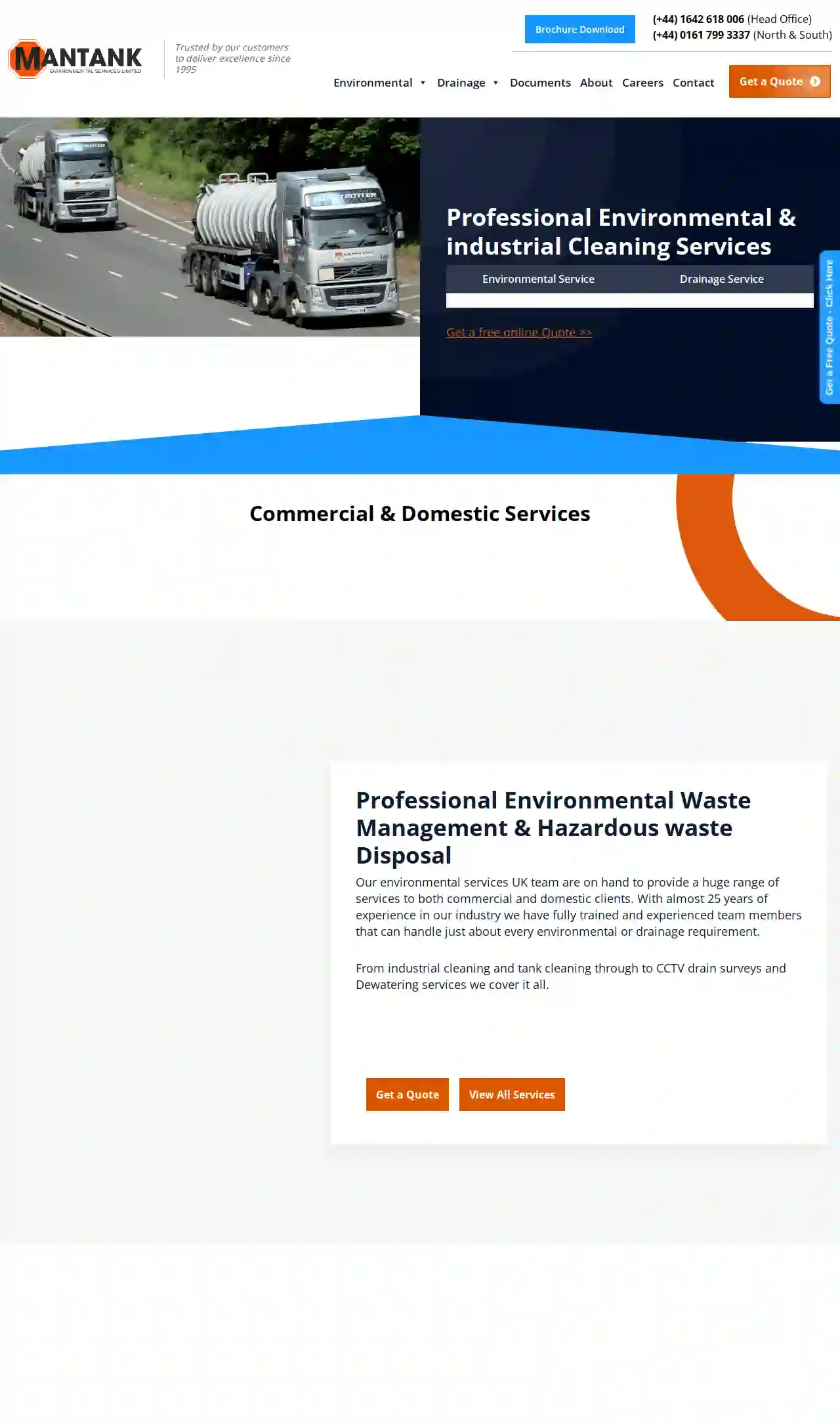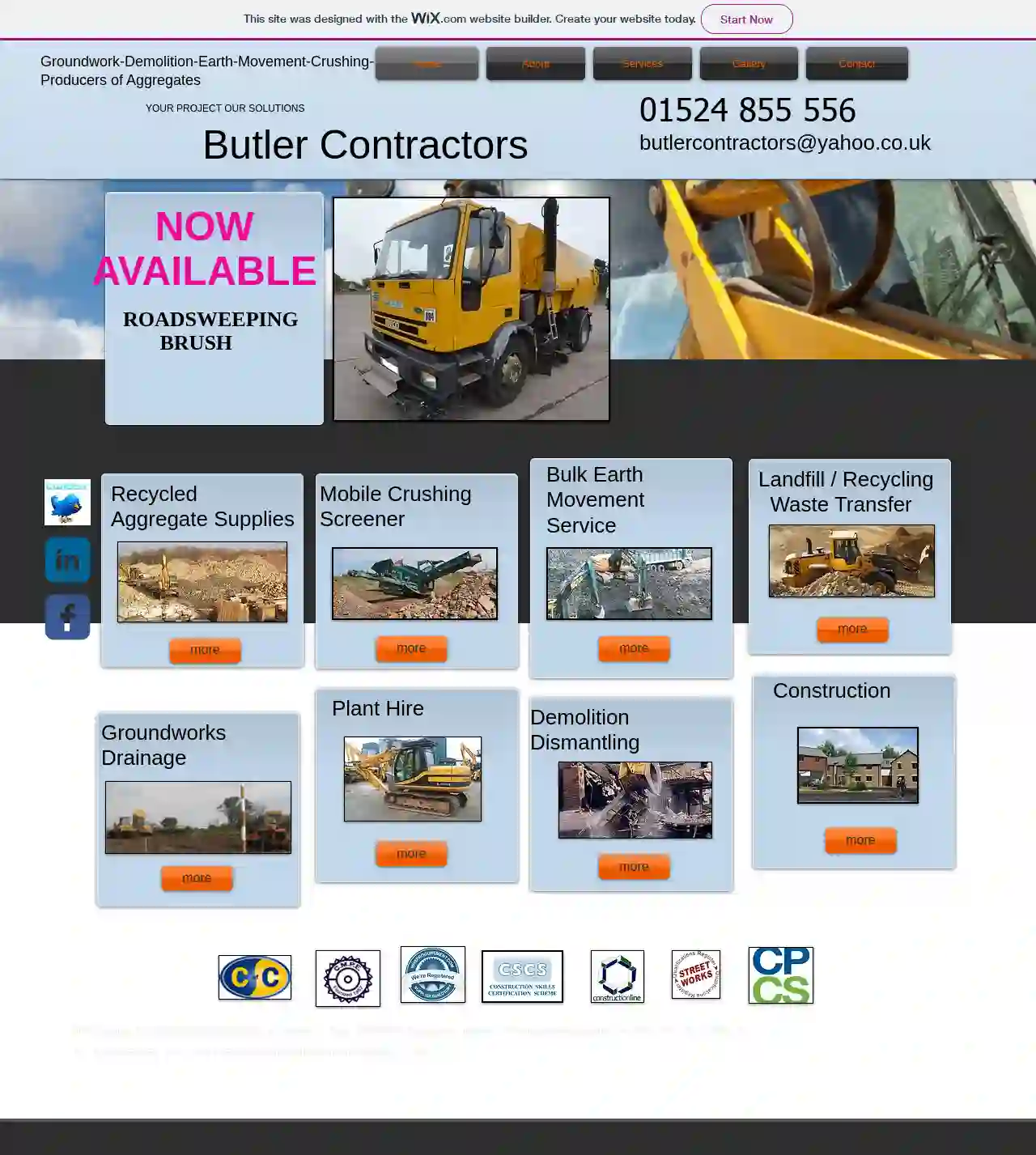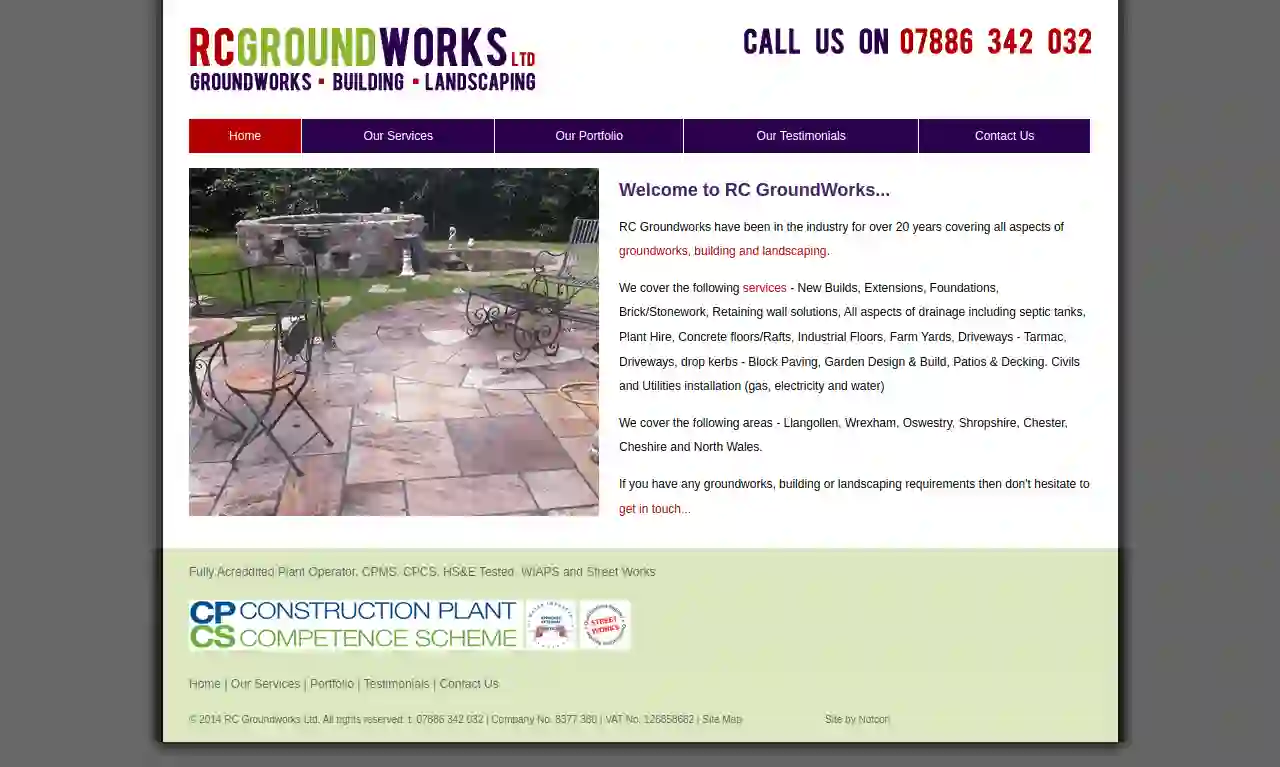Excavation Contractors Helsby
Find the best Excavation Services in Helsby
Get up to 3 Excavation Services quotes for your project today! Compare profiles, reviews, accreditations, portfolio, etc... and choose the best service.

Mantank Environmental Services Limited
4.52 reviewsHill House Farm, Redmarshall Road, Redmarshall, Stockton on Tees, Stockton-on-Tees, TS21 1EW, GBTrusted by our customers to deliver excellence since 1995 Mantank Environmental Services Ltd is a leading provider of environmental and drainage services across the UK. We have a proven track record of delivering high-quality, cost-effective solutions to a wide range of clients, from small businesses to large corporations. Our team of experienced professionals is committed to providing our clients with the best possible service, and we are always striving to improve our processes and technologies to ensure that we are meeting the ever-changing needs of our industry. Our Services We offer a wide range of environmental and drainage services, including: Tank Cleaning Industrial Cleaning Sewage Tank Cleaning Tank Decommissioning Chemical Waste Disposal Environmental Services UK Water Tank Cleaning Dewatering Services Waste Management Company Water Jetting Vessel Cleaning Industrial Vacuum Sludge and Silt Removal Industrial Tank Cleaning SuDS Pond Maintenance CCTV Drain Survey Drain Camera Drain Clearance Drain Inspection Drain Repair Drainage Services Our Commitment to Quality We are committed to providing our clients with the highest quality services. We are fully accredited and insured, and we are always striving to improve our processes and technologies to ensure that we are meeting the ever-changing needs of our industry. Our Team Our team of experienced professionals is committed to providing our clients with the best possible service. We are always happy to answer any questions you may have, and we are always striving to improve our processes and technologies to ensure that we are meeting the ever-changing needs of our industry.
- Services
- Why Us?
- Gallery
Get Quote
Pre-Construct Archaeology Winchester
51 reviewsThe Granary, Rectory Farm, Pampisford, Cambridgeshire, Cambridge, CB22 3EN, GBPre-Construct Archaeology (PCA) is a well-established independent archaeological company specializing in high-quality, client-focused heritage initiatives. PCA provides the full range of archaeological and built heritage services in all public and private sectors, such as property development, transport, and renewable energy. We are able to undertake work anywhere in the UK, including contaminated sites. PCA undertakes projects of all sizes in many diverse sectors. We have worked on major infrastructure projects encompassing several large-scale investigations, and in notable locations such as Westminster Abbey and King’s Cross Central. With offices in Cambridge, Durham, London, Newark, Norwich, Warwick, and Winchester, we can help with your heritage requirements. Get in touch with Pre-Construct Archaeology in your local area or contact our general enquiries for advice.
- Services
- Why Us?
- Testimonials
- Gallery
Get Quote
Groundworks Driveways & Patios
58 reviewsWaters Green House, Waters Green, Waters Green HouseWaters GreenMacclesfield, Macclesfield, SK11 6LF, GBAbout Groundworks Driveways & Patios Ltd Groundworks Driveways and Patios Ltd specialise in a wide variety of driveways and block paving work, with many years experience with in the trade. Our experienced and professional staff can offer you free impartial advice on all your block paving driveway requirements. With years of experience in the building field, you can be confident of our quality and reliability. All our work is fully guaranteed and carried out to your total satisfaction. Our Services Groundworks Driveways & Patios offer a full range of traditional colours and designs along with a complete service, with site preparation if necessary. Why Choose Groundworks Driveways? Unbeatable value for Patios, Driveways, Block Paving, Resin Driveways & Landscaping in Macclesfield and the surrounding areas. It’s simple, we don’t have an unnecessary showroom, pushy sales team or cheesy TV adverts, this allows us to keep our overheads low and pass on that saving to you, the customer. At the end of the day all you need and all your looking for is a qualified and experienced paving company to install your new outdoor patio or driveway surface at an unbeatable price, and we are proud to be able to offer the best prices in Macclesfield.
- Services
- Why Us?
- Testimonials
- Gallery
Get Quote
Concourse Shopping Centre
3.2Concourse Centre, Southway, Skelmersdale, WN8 6LN, GBThe Concourse Shopping Centre: Your One-Stop Shop in Skelmersdale Nestled in the heart of Skelmersdale, West Lancashire, The Concourse Shopping Centre is a vibrant hub for shoppers seeking a diverse range of retail experiences. With nearly 100 retailers under one roof, you'll find everything you need and more. From national brands like Aldi, Home Bargains, Argos, and Boots to independent retailers and food outlets, The Concourse offers a mix of options to suit every taste and budget. Explore the centre's ground and first floors, discover your favourite stores, and enjoy a convenient shopping experience. The Concourse is managed by London & Cambridge Properties Ltd. For more information about LCP, visit their website at www.lcpproperties.co.uk .
- Services
- Why Us?
- Our Team
- Gallery
Get Quote
Drainage Care
53 reviewsChester, GB24/7 Emergency Drainage Repair At Drainage Care UK, we're dedicated to providing experienced, reliable, and courteous drainage services for all our customers. We understand that dealing with an emergency drainage problem at any time can be stressful, which is why we offer a fast and efficient drain unblocking service. Our team is equipped to handle a wide range of drainage and plumbing issues, including blocked drains, sink repairs, and CCTV drain surveys for both residential and commercial properties. We're committed to leaving no stone unturned in resolving your drainage problems. We're always ready to help, with a team of friendly staff available 24/7.
- Services
- Why Us?
- Testimonials
- Gallery
Get Quote
Geobear
51 reviewsUnit 1, The Dell Business Park, Unit 1 The Dell Business Park Enterprise Drive Four Ashes Wolverhampton, Wolverhampton, WV10 7DF, GBGeobear: Your Trusted Partner for Ground Engineering Solutions Geobear is an international ground engineering organisation that provides solutions for home subsidence issues and ground improvement for infrastructure and commercial sites. Whether under a home, commercial property or major infrastructure, Geobear’s fast, cost-effective solutions improve the ground, fills voids and lift slabs with barely any disruption. Having carried out over 200,000 successful projects, Geobear is a trusted partner for industry and homeowners alike. Our Commitment to Sustainability Behind everything that Geobear does is the goal of driving the transition to socially responsible ground improvement. Our values of safety, partnership, integrity, respect and excellence mean that we always strive to provide our customers with the most convenient, reliable and cost-effective solution whilst minimising harm to people and the environment. A Legacy of Innovation Geobear invented the process of geopolymer injection in the 1980’s. Our expert ground engineers have developed a range of innovative solutions that are both effective and environmentally friendly. We are constantly striving to improve our processes and develop new solutions to meet the ever-changing needs of our customers.
- Services
- Why Us?
- Gallery
Get Quote
Excavation Solutions
525 reviews5892 Taylor rd, Painesville, 44077, GBAt Excavation Solutions, we strive for quality and perfection in every excavation project. Our dedicated two-man crew, led by Matt Slezak and Alex Edmunds, works hard to ensure every job is executed with precision and care. We treat our customers like family and will make sure your excavation needs are fulfilled to the highest standard. From commercial and residential excavation to special projects and infrastructure excavation, we offer a range of services to meet your needs. Our services include shoring, sheet piling, erosion control, pond/lake installation, pond/lake repair/dredging, dock repair/installation, commercial and residential drainage pipe work, and waterproofing. We are committed to delivering exceptional results and building long-lasting relationships with our clients.
- Services
- Why Us?
- Our Team
- Gallery
Get Quote
Butler Contractors
3.73 reviews95 King Street, Lancaster, 95 King Street Lancaster, LA1 1RH, GBButler Contractors Groundwork-Demolition-Earth-Movement-Crushing- Producers of Aggregates YOUR PROJECT OUR SOLUTIONS
- Services
- Why Us?
- Gallery
Get Quote
RC Groundworks Ltd
51 reviews26 Maes Pengwern, Llangollen, LL20 8BA, GBWelcome to RC GroundWorks RC Groundworks has been serving the industry for over 20 years, providing comprehensive groundworks, building, and landscaping solutions. We are committed to delivering high-quality workmanship and exceeding client expectations. Our team of experienced professionals is dedicated to providing a wide range of services, including: New Builds Extensions Foundations Brick/Stonework Retaining wall solutions All aspects of drainage including septic tanks Plant Hire Concrete floors/Rafts Industrial Floors Farm Yards Driveways - Tarmac, Driveways, drop kerbs - Block Paving Garden Design & Build Patios & Decking Civils and Utilities installation (gas, electricity and water) We proudly serve the following areas: Llangollen Wrexham Oswestry Shropshire Chester Cheshire North Wales Whether you're embarking on a new construction project, renovating your home, or enhancing your outdoor space, RC Groundworks is your trusted partner. Contact us today to discuss your project and receive a free, no-obligation quote.
- Services
- Why Us?
- Gallery
Get Quote
ESP Construction
43 ST. ASAPH ROAD, DYSERTH, RHYL, CLWYD, Dyserth, LL18 6HG, GBAbout ESP Construction ESP Construction is a team of experienced building contractors based in Dyserth, Denbighshire. We offer a wide range of building and groundwork services, including extensions, alterations, new builds, drainage groundworks, driveways, and all aspects of hard and soft landscaping. Established for over 20 years, we have a proven track record of delivering successful projects for both commercial and residential customers. We are committed to providing a high-quality and safe service every time, which is why we are CHAS safety accredited and ISO 9001 quality management accredited. Our service area primarily covers North Wales, including Denbighshire, Conwy, Flintshire, Wrexham, and surrounding areas of the North West, such as Cheshire, Wirral, and Ellesmere Port. We are also able to accommodate nationwide services where required. We are passionate about delivering exceptional results for our clients. We take pride in our attention to detail, our commitment to quality, and our ability to work collaboratively with our clients to achieve their vision.
- Services
- Why Us?
- Accreditations
- Testimonials
- Gallery
Get Quote
Over 13,059+ Excavation Businesses registered
Our excavation contractors operate in Helsby & surrounding areas!
ExcavationHQ has curated and vetted the Best Excavation Businesses arround Helsby. Find the most reliable business today.
Frequently Asked Questions About Excavation Contractors
- Spring and Fall: Often considered favorable due to moderate temperatures and drier soil conditions.
- Summer: Can be suitable, but hot weather can make working conditions challenging and might require additional measures (shade, hydration) for workers.
- Winter: Excavation in winter can be more difficult due to frozen ground, snow, and potential delays caused by inclement weather. It might also require specialized equipment or techniques.
- Clear the Area: Remove any obstacles, including vehicles, outdoor furniture, landscaping features, or structures, from the excavation zone and surrounding area.
- Mark Existing Features: Identify and mark underground utilities, septic tanks, sprinkler systems, or other buried elements you want to protect.
- Protect Landscaping: Use tarps or fencing to shield trees, shrubs, gardens, or other landscaping elements from damage.
- Provide Access: Ensure the excavation contractor has clear access to the work area, including gates wide enough for equipment.
- Discuss Logistics: Coordinate with the contractor regarding parking arrangements, material delivery, and any special instructions or concerns you might have.
- Determining Soil Suitability: Assessing whether the soil can support the intended structure or load.
- Recommending Foundation Types: Advising on the appropriate foundation design based on soil characteristics.
- Addressing Drainage and Erosion Issues: Providing solutions to manage water runoff and prevent erosion.
- Evaluating Slope Stability: Assessing the risk of landslides or soil movement on slopes.
- Building on challenging soil types (expansive clay, loose sand, etc.)
- Constructing large or complex structures
- Excavating near slopes or retaining walls
- Addressing drainage or erosion concerns
- Soil Type and Stability: Stable, cohesive soils allow for deeper excavations than loose or unstable soils.
- Groundwater Level: Excavations below the water table require dewatering techniques to manage water intrusion.
- Equipment and Resources: The size and capabilities of excavation equipment influence the achievable depth.
- Safety Regulations: OSHA and other safety regulations impose limitations on trench depths without proper shoring or sloping.
- Project Requirements: The purpose of the excavation (basement, pool, foundation) determines the necessary depth.
What is the best time of year for excavation?
How do I prepare my property for excavation?
What is a soil engineer, and do I need one?
How deep can you excavate?
What is the best time of year for excavation?
- Spring and Fall: Often considered favorable due to moderate temperatures and drier soil conditions.
- Summer: Can be suitable, but hot weather can make working conditions challenging and might require additional measures (shade, hydration) for workers.
- Winter: Excavation in winter can be more difficult due to frozen ground, snow, and potential delays caused by inclement weather. It might also require specialized equipment or techniques.
How do I prepare my property for excavation?
- Clear the Area: Remove any obstacles, including vehicles, outdoor furniture, landscaping features, or structures, from the excavation zone and surrounding area.
- Mark Existing Features: Identify and mark underground utilities, septic tanks, sprinkler systems, or other buried elements you want to protect.
- Protect Landscaping: Use tarps or fencing to shield trees, shrubs, gardens, or other landscaping elements from damage.
- Provide Access: Ensure the excavation contractor has clear access to the work area, including gates wide enough for equipment.
- Discuss Logistics: Coordinate with the contractor regarding parking arrangements, material delivery, and any special instructions or concerns you might have.
What is a soil engineer, and do I need one?
- Determining Soil Suitability: Assessing whether the soil can support the intended structure or load.
- Recommending Foundation Types: Advising on the appropriate foundation design based on soil characteristics.
- Addressing Drainage and Erosion Issues: Providing solutions to manage water runoff and prevent erosion.
- Evaluating Slope Stability: Assessing the risk of landslides or soil movement on slopes.
- Building on challenging soil types (expansive clay, loose sand, etc.)
- Constructing large or complex structures
- Excavating near slopes or retaining walls
- Addressing drainage or erosion concerns
How deep can you excavate?
- Soil Type and Stability: Stable, cohesive soils allow for deeper excavations than loose or unstable soils.
- Groundwater Level: Excavations below the water table require dewatering techniques to manage water intrusion.
- Equipment and Resources: The size and capabilities of excavation equipment influence the achievable depth.
- Safety Regulations: OSHA and other safety regulations impose limitations on trench depths without proper shoring or sloping.
- Project Requirements: The purpose of the excavation (basement, pool, foundation) determines the necessary depth.